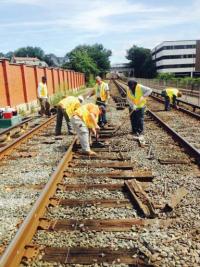November 5, 2015
 Workers fix up tracks between North Quincy and JFK stations. Photo courtesy Mass DOTWinter has not yet descended on the commonwealth, but preparations are underway to bring the Red Line up to facing the challenge.
Workers fix up tracks between North Quincy and JFK stations. Photo courtesy Mass DOTWinter has not yet descended on the commonwealth, but preparations are underway to bring the Red Line up to facing the challenge.
Shuttles will replace trains entering or exiting the JFK/UMass stop each weekend in November, MassDOT officials have announced as improvement work continues on the line.
Gov. Charlie Baker’s $83 million winter preparation plan for the MBTA includes setting up a number of safeguards intended to thwart the causes of rapid transit gridlock during last year’s historic winter.
Among the improvements: third rail replacement, snowplow installation, heating infrastructure, and snow fence installations.
Efforts are moving forward even as an expensive train control system presses an already tight MBTA budget and officials debate another round of possible fare increases.
According to State House News Service, the MBTA on Monday was authorized to negotiate a contract valued at $338.4 million to implement positive train control systems on the commuter rail lines that will automatically keep trains on the correct routes.
The most substantial element of the rehabbing is the third rail and heating infrastructure being laid from the Andrew Square tunnel through to Ashmont and Braintree on the southern legs of the Red Line.
According to MassDOT spokesman Jason Johnson, 44,059 feet of new third rail had been laid as of Oct. 19. Heater element infrastructure upgrades have been made to about 23,470 feet, with complete heater element replacement now reaching about 21,708 feet. Both the rail and heater upgrades should better protect the rails from freezing over or losing contact with the trains during extreme cold weather.
“The primary focus is on the Braintree branch, which experienced the most detrimental impacts caused by last winter,” Johnson said in an email. That liner possesses the longest contiguous section of exposed rail — 48,055 feet.
The T’s new chief strategy officer, Scott Bosworth, a daily transit commuter and Dorchester resident, notes that “the Ashmont line is much more resilient in many respects because you have the tunnels,” adding that the higher amount of train traffic also kept the tracks from becoming too clogged with snow this last winter, so they “did not experience as many problems.”
Workers have been laying new rail for the past several weekends, during full shutdowns from end of service Friday to start of normal service Monday. Train service along the Red Line will be replaced with shuttle buses between the JFK/UMass and Park Street stations on Nov. 7-8, as well as Nov. 14-15 and Nov. 21-22 between JFK/UMass and Braintree Stations.
MBTA officials expected work on the rails to reach Wollaston station by the end of this year, but Johnson said the contractors had been exceeding expectations through mid-September.
Among the other winterizing improvements:
• 20 stainless steel plows each for the Red and Orange Lines, to be mounted in November and December, with an additional 20 plows for each line are expected to be delivered in late January.
• Filter reactor line chokes, which are designed to “absorb or minimize voltage spikes during service” are in the process of being installed.
• Snow fence installation should begin within a few weeks.


